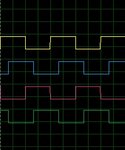Nysix
Junior Member level 2
Hi all,
Firstly, I'm new in this forum ;-) I don't speak english very well... Sorry in advance :-(
I need to design a full bridge inverter using IR2110 and IGBT (IRG4BC30) to vary the AC motor (150W) velocity. The switching will be
and I'll make it using a PIC16F877A.
I'm rectifying the line voltage (60 Hz, 180 V peak voltage) using a full bridge rectifier (MUR460 diodes). I have tested all schemes that I found, but I can't put them to work... I'm using the ISIS to simulate the circuit, but it don't work... I really need help to make this work. Anybody have a example or a tested scheme?
Other doubt, IR2110 and IR2112, for my purpose, are equivalents?
Thanks
Firstly, I'm new in this forum ;-) I don't speak english very well... Sorry in advance :-(
I need to design a full bridge inverter using IR2110 and IGBT (IRG4BC30) to vary the AC motor (150W) velocity. The switching will be
and I'll make it using a PIC16F877A.
I'm rectifying the line voltage (60 Hz, 180 V peak voltage) using a full bridge rectifier (MUR460 diodes). I have tested all schemes that I found, but I can't put them to work... I'm using the ISIS to simulate the circuit, but it don't work... I really need help to make this work. Anybody have a example or a tested scheme?
Other doubt, IR2110 and IR2112, for my purpose, are equivalents?
Thanks




